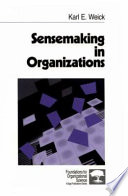

Sensemaking is a process through which individuals and groups interpret and understand their experiences and environments. It involves constructing meaning from complex, often ambiguous situations, allowing organizations to navigate change and uncertainty. The book emphasizes that sensemaking is not a solitary act but a collective endeavor, where shared understanding among team members is crucial. It highlights the importance of context, as the same event can be interpreted differently based on the perspectives of those involved. By engaging in sensemaking, organizations can better respond to challenges and opportunities, fostering adaptability and innovation.
Continue readingSocial interaction is fundamental to the sensemaking process. The book discusses how communication and collaboration among team members contribute to a shared understanding of events and decisions. Through dialogue, individuals can challenge assumptions, share insights, and co-create meaning. The authors argue that organizations should cultivate an environment that encourages open communication and diverse perspectives, as this enhances collective sensemaking. By leveraging the social dynamics within teams, organizations can improve their problem-solving capabilities and resilience in the face of change.
Continue readingNarratives play a significant role in sensemaking, as they help individuals and organizations construct coherent stories about their experiences. The book explores how narratives shape perceptions, guide actions, and influence decision-making. By framing events within a narrative context, organizations can make sense of complex situations and align their strategies with their values and goals. The authors suggest that leaders should actively engage in storytelling to communicate vision and inspire action, fostering a sense of purpose and direction within the organization.
Continue readingCues and triggers are critical elements in the sensemaking process, as they prompt individuals to pay attention to specific events or changes in their environment. The book outlines how organizations can identify and leverage these cues to enhance their sensemaking capabilities. By being attuned to subtle signals in the environment, organizations can anticipate challenges and opportunities, enabling proactive rather than reactive responses. The authors emphasize the need for leaders to foster a culture of awareness and vigilance, encouraging team members to be observant and responsive to their surroundings.
Continue readingOrganizational culture significantly impacts the sensemaking process. The book discusses how shared values, beliefs, and norms shape the way individuals interpret events and make decisions. A culture that promotes openness, learning, and experimentation fosters effective sensemaking, while a culture of fear or rigidity can hinder it. The authors argue that leaders must be intentional about cultivating a culture that supports sensemaking, as this can enhance organizational agility and resilience. By aligning culture with sensemaking practices, organizations can better navigate complexity and uncertainty.
Continue readingChange is a constant in organizational life, and effective sensemaking is crucial for navigating it successfully. The book explores how organizations can use sensemaking to manage transitions, whether they are planned or emergent. The authors highlight the importance of flexibility and adaptability in the face of change, as well as the need for ongoing sensemaking to reassess and realign strategies. By fostering a culture of continuous learning and reflection, organizations can enhance their capacity to respond to change and leverage it as an opportunity for growth.
Continue readingThe book provides practical frameworks and tools for implementing sensemaking within organizations. It emphasizes the need for leaders to facilitate sensemaking processes, such as conducting regular reflection sessions, encouraging dialogue, and utilizing visual aids to map out complex situations. The authors also discuss the role of technology in supporting sensemaking, highlighting tools that can enhance communication and collaboration. By adopting these practices, organizations can strengthen their sensemaking capabilities, leading to improved decision-making and strategic alignment.
Continue reading